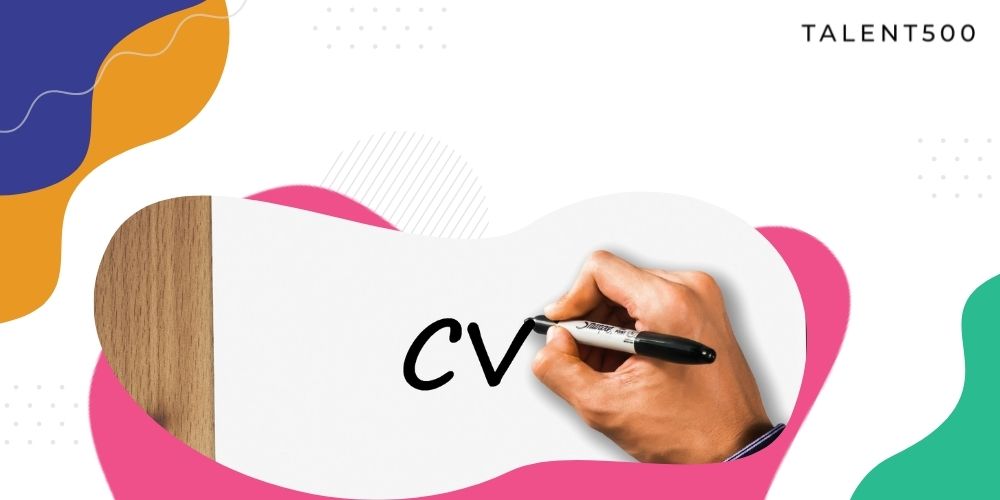Recruiters make a sense of a candidate from their CV before deciding to call them for an interview. This is why CVs hold such importance when you apply for a job, they create that first impression about you. According to a study, recruiters on average spend just seven seconds to decide whether a candidate is right for the role or not. This is why it is important to mindfully create CVs that make you stand out as a candidate.
Structure your resume properly
Just like a clean code, your CV has to have a clean and easy-to-follow structure. Here is a resume that follows the right information hierarchy.
It is a subtle yet engaging CV format that presents the work experience in chronological format. It doesn’t use any block design or background to create sections but bolded heading. The entire text follows the same font size (11-12 point size) and style. When you create such a resume it is important to maintain a uniform margin on all sides of the document. We recommend maintaining an inch of margin.
This is about formatting, next is to be attentive to the content structure. For a software engineering resume, maintain this structure of the content.
Start with contact Details, followed by a resume introduction. Next, add work experience in chronological order with the recent post at the top. Then you can list any relevant information related to education before concluding with relevant skills that highlight your strength for the role.
Resume for mid-level software engineer
The format above is well-suited for most roles, but if you want to format it a little differently here is an example that is ideal for mid-level software engineering resumes. You can split the resume into two sections to segregate personal and professional information.
In this example, the resume has the education and courses on the left side, while work experience and skills are on the right. This is helpful to navigate through the information and avoids any confusion. Another thing to notice here is how well the candidate has condensed his reasonable amount of experience to highlight only the main responsibilities. Also, he managed to mention keywords like ‘Updated 30+ custom .net applications’, ‘Used JavaScript codebase to reduce the loading time of the company’s website by 65%’ and ‘Trained new staff’.
Senior software engineer resume
If you pay attention to this template, you notice how it makes use of the white space to create an easily readable resume. The subtle patterns in the background prevent it from appearing monotonous without disturbing the overall look.
The sections are created just using bold headings just like the first template. It follows the chronological format to list experiences but focuses on how concise the job responsibilities are. The candidate has managed to put in all the core and competent responsibilities associated with her role as a senior engineer. She has also created a good mix of explaining measurable achievements associated with roles in the past along with keywords.
Front end engineer resume example
This resume stands out because of the colour scheme. Albeit using a creative CV template, it has stood out because it has a clear and clean professional look. The problem with most artistic/design-led resumes is that at times, candidates overdo it, resulting in too much distraction.
Here’s an example of a bad artistic resume:
When you are working with such a CV template, make a strong profile presentation that highlights your experience and skills. This is again a two-column design that segregates the work and skill information from education and personal content.
Back-end engineer CV template
There is no confusion here, the candidate has made it clear from the start with the use of a prominent heading that he is a backend engineer. He further emphasizes his intentions by using the appropriate keywords related to the job in the rest of the resume. He has clearly outlined his skills as a backend engineer by explaining his job responsibilities such as ‘built and coded 8 web applications’, ‘provided code maintenance and up gradation to boost system performance by 65%’, and ‘Confident in designing APIs.’
Such a resume will easily pass through ATS screening software if a company uses one. Also, he has managed to make his resume stand out by adding some personality to it with the use of shapes in the background.
Conclusion
The CV templates can be very subjective depending on what role you are applying for. As you cannot predict what a recruiter will like in a resume, still there are some ground rules you must follow. Add keywords to be ATS compliant, match the work experience and skills you mention with the job description and do not just list past job roles, add details of what responsibilities you handled and accomplishments.
Talent500 is helping candidates get their dream jobs at some of the best global tech companies. Join our elite team of prospective job seekers and get unmatched upskilling opportunities. Sign up here.




